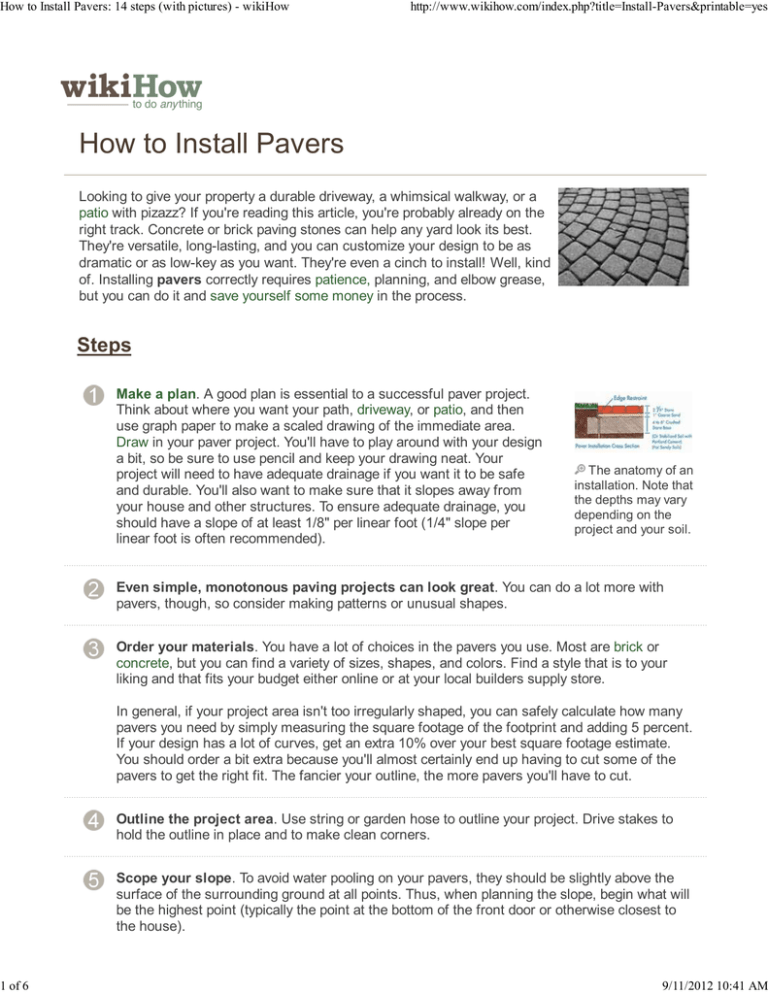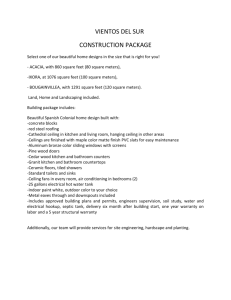How to Install Pavers: 14 steps (with pictures) - wikiHow
advertisement

How to Install Pavers: 14 steps (with pictures) - wikiHow 1 of 6 http://www.wikihow.com/index.php?title=Install-Pavers&printable=yes How to Install Pavers Looking to give your property a durable driveway, a whimsical walkway, or a patio with pizazz? If you're reading this article, you're probably already on the right track. Concrete or brick paving stones can help any yard look its best. They're versatile, long-lasting, and you can customize your design to be as dramatic or as low-key as you want. They're even a cinch to install! Well, kind of. Installing pavers correctly requires patience, planning, and elbow grease, but you can do it and save yourself some money in the process. Steps Make a plan. A good plan is essential to a successful paver project. Think about where you want your path, driveway, or patio, and then use graph paper to make a scaled drawing of the immediate area. Draw in your paver project. You'll have to play around with your design a bit, so be sure to use pencil and keep your drawing neat. Your project will need to have adequate drainage if you want it to be safe and durable. You'll also want to make sure that it slopes away from your house and other structures. To ensure adequate drainage, you should have a slope of at least 1/8" per linear foot (1/4" slope per linear foot is often recommended). The anatomy of an installation. Note that the depths may vary depending on the project and your soil. Even simple, monotonous paving projects can look great. You can do a lot more with pavers, though, so consider making patterns or unusual shapes. Order your materials. You have a lot of choices in the pavers you use. Most are brick or concrete, but you can find a variety of sizes, shapes, and colors. Find a style that is to your liking and that fits your budget either online or at your local builders supply store. In general, if your project area isn't too irregularly shaped, you can safely calculate how many pavers you need by simply measuring the square footage of the footprint and adding 5 percent. If your design has a lot of curves, get an extra 10% over your best square footage estimate. You should order a bit extra because you'll almost certainly end up having to cut some of the pavers to get the right fit. The fancier your outline, the more pavers you'll have to cut. Outline the project area. Use string or garden hose to outline your project. Drive stakes to hold the outline in place and to make clean corners. Scope your slope. To avoid water pooling on your pavers, they should be slightly above the surface of the surrounding ground at all points. Thus, when planning the slope, begin what will be the highest point (typically the point at the bottom of the front door or otherwise closest to the house). 9/11/2012 10:41 AM How to Install Pavers: 14 steps (with pictures) - wikiHow 2 of 6 http://www.wikihow.com/index.php?title=Install-Pavers&printable=yes Drive a stake at the high point, and mark the correct height where the pavers will meet the door or structure. Tie a string around the stake at that height. Drive a stake (if there isn't already one) at the outer boundary of your project. This will be your lowest point. Attach a line level to your string and then tie the loose end of the string around the outer stake at the height at which the line level tells you the entire string is level. Now from that line move down the stake at least 1/8" per linear foot (e.g. if it is 8 feet from your front door to the outer edge of your patio, move down the stake 1"), and draw a new line. Move your string down to this line. String cross-lines down the length of the project to ensure you mark the correct depth across the entire project. If your project area has a variety of slopes, or if your design is irregular, you'll need to repeat this process in several points. It is absolutely critical that you get the slope right, so the more stakes, the better. Excavate the installation area. Spaces which will be exposed only to foot traffic generally need 4-6" of base material, while driveways or projects in very wet soil may need as much as 12" of base. Figure out how deep your base will need to be (consult the manufacturer or your building supply store), and add about 1-1.5" for the sand layer, plus the thickness of the pavers (this varies by brand and style but is typically 2 3/8" or 3 1/8"). The sum of the depth of the base, the sand, and the pavers will be how deep you need to excavate your project area. Be sure to excavate 6-12" beyond the boundaries of the project to give you ample space to install your edge restraints. Measure the depth of your excavation from the string you used to track your slope, not from the surface of the ground. Lay the base. The base material is usually coarse, crushed stone with sharp irregular edges. Add no more than 2" at a time to the entire excavated area, and then compact it with a hand tamper (for very small projects) or a plate compactor. It's essential that the base be well-compacted. Repeat this process until you have a base of the correct depth. Now is your last chance to properly adjust the height of the finished project and to ensure you don't have any dips or bumps. Slightly increase or decrease the thickness of the base as necessary, taking frequent measurements from your strings to the base. Laying the base outside the boundaries of the project will make your project more stable. Measure the depth of your excavation frequently. Measure from the line, not from the surface of the ground. Use a plate compactor to compact the base. Install the edge restraints. Edge restraints will help hold the shape of your project over the years. Place these restraints, usually made of plastic, aluminum, or steel, around the perimeter of the project and secure them into the ground with 12" spikes. If your design is irregularly shaped, you'll need to cut the restraints in order to follow the edges of your design. 9/11/2012 10:41 AM How to Install Pavers: 14 steps (with pictures) - wikiHow 3 of 6 http://www.wikihow.com/index.php?title=Install-Pavers&printable=yes Install the edge restraints and secure them with landscaping spikes. Put down a layer of sand. The sand is the glue that holds your pavers in place. Use coarse sand and screed it smooth to a uniform depth of 1-1.5"--no more. If your project is large, lay down 1" screed pipes and then pour the sand in between the pipes, screeding the sand in small sections (50-100 square feet each). Remove the pipes and then fill in the gaps with more sand. Screed the sand until you have a smooth, even layer. 10 Lay the pavers. Actually laying pavers is easy compared to all the work you've just done. Begin laying pavers at a 90-degree corner, preferably one that abuts the house or another structure. Work out from there, keeping your pavers in straight lines. Lay pavers by placing them straight down in the sand--do not slide them along the ground or kick them into place and disturb the sand. Slide each paver straight down the edge of the adjacent paver. Don't worry about gaps: you generally want to leave a 1/16" to 1/8" gap between pavers. Periodically check to make sure the pavers are level, and use a string to check each row for straightness. Lay the pavers working out from one corner. Keep your lines straight, and work from on top of the pavers you have already installed. You'll almost invariably need to cut some pavers to fit the edges. Don't try to curve your pavers to fit the edging. Instead, lay all the whole pavers you can in each row and then go back and cut pavers to the correct sizes to fit the edge. Use a masonry saw or a guillotine-style splitter to make good, clean cuts. Do not step on your prepared sand. Stand on the pavers you have already installed and work your way out. Don't get too close to the edge of the pavers you've installed, or you might disturb the sand in front of them. Use a plate compactor to tamp the pavers into the sand. Once all the pavers are installed, run the plate compactor over them to ensure they are snuggly pressed into the sand. 9/11/2012 10:41 AM How to Install Pavers: 14 steps (with pictures) - wikiHow 4 of 6 http://www.wikihow.com/index.php?title=Install-Pavers&printable=yes Use the plate compactor to set the pavers in place. 12 Sweep sand into the joints. Fill the joints between pavers with coarse sand like you used earlier, or use slightly finer sand. Pour it onto the pavers and sweep it into the cracks until they are completely filled. This sand "locks" the pavers in place. Make sure the sand is dry. Dump sand liberally over the installed pavers and sweep it into the joints until all the cracks are filled. 13 Seal your pavers. For added durability and lower maintenance, seal the pavers with an appropriate sealing product. This will keep the sand between the joints in place and help prevent weed growth. 14 To see a full video explaining how to install pavers, Please check out: http://www.gopavers.com/pavers_installation/ Tips These are general guidelines only. Check your paver manufacturer's recommendations before laying pavers. If you have sandy soil, you may be able to mix 1 94-pound bag of Portland cement into each 30 square feet of your soil as a base. Do this only if you're installing a walkway or patio that will receive only foot traffic. Clay soil can be particularly shifty over time. You can add stability to your project by covering the bottom and sides of the excavation with a geotextile layer before you add your base. 9/11/2012 10:41 AM How to Install Pavers: 14 steps (with pictures) - wikiHow 5 of 6 http://www.wikihow.com/index.php?title=Install-Pavers&printable=yes Spray your base gravel lightly with water to moisten it. This will make it easier to compact the base correctly. In southern climates not subject to freeze thaw, a concrete toe can be used in place of edge restraints, and for some projects, such as driveways, a toe is not preferred. Install the toe after you have already installed the pavers. In southern climates not subject to freeze thaw, a concrete toe can be added instead of using edge restraints. This is not recommended for driveways in any climate. Check out How to Install Paving Stones Video (http://www.youtube.com /watch?v=FThzcnP_EP0 ) Also instead of using a concrete toe, you can place wet portland and base mixed together under the border pavers. For instance: you are using a 6"x9" paver as a soldier border for a driveway. You excavate out the compacted base the entire length under the border, mix in portland and water. Then set it back in the area. Place the soldier paver back into the wet concrete mix and hammer back to level.You have basically just created a 9" wide concrete beam that is not visible to the viewer. If it does crack, it is rare that a 9" wide concrete beam buried below grade would move. Warnings Always check with your local utility company before doing any excavating. Remember, hitting a power line can result in injury or death. Exercise caution when using tools, such as a plate compactor and saw. Follow the manufacturer's instructions and heed all safety warnings. Be sure to wear safety glasses when cutting pavers. Things You'll Need Paving stones (pavers) Base material--coarse gravel, etc. Sand 9/11/2012 10:41 AM How to Install Pavers: 14 steps (with pictures) - wikiHow 6 of 6 http://www.wikihow.com/index.php?title=Install-Pavers&printable=yes Edge restraints or concrete toes Transit Level String, stakes, and a level Measuring tape Graph paper and pencil Plate compactor or tamper Screed boards or pipes Masonry saw or guillotine style stone cutter Eye protection Related wikiHows How to Install Patio Pavers How to Clean Pavers How to Install a Brick Walkway How to Pedestal Pavers Installation How to Seal Between Paving Stones How to Repair a Sinking Stone Patio How to Inexpensively Increase the Value of Your Home How to Build Fake Rock with Cement How to Build a Dry Stack Retaining Rock Wall How to Remove Oil Stains from Concrete Driveway and Garage How to Install an Artificial Lawn Sources and Citations TileTechPavers.com Detailed installation guide and Paver products. The source of the images for this article, shared with permission. Pacificpavingstone.com For more information, FAQ's, Galleries, how to video's and tips regarding paving stones. 9/11/2012 10:41 AM





